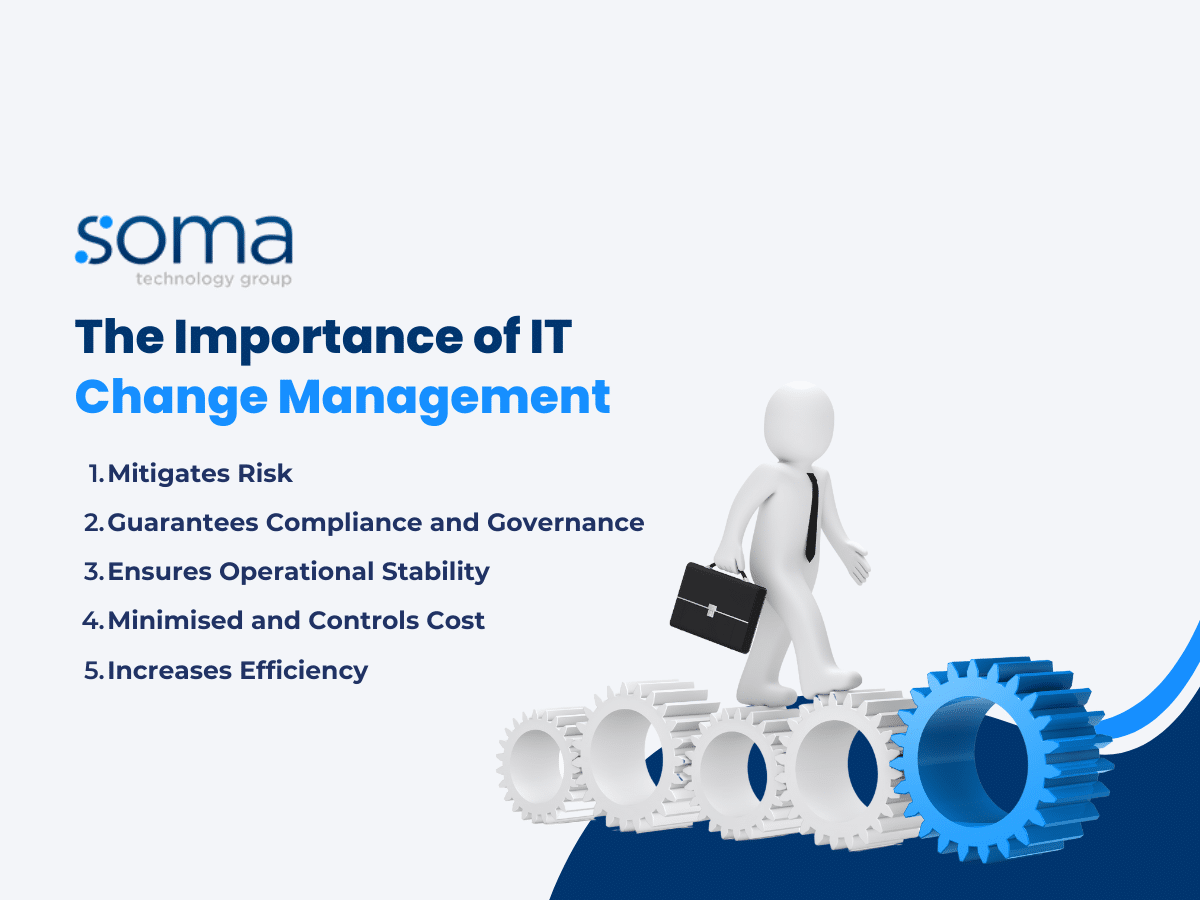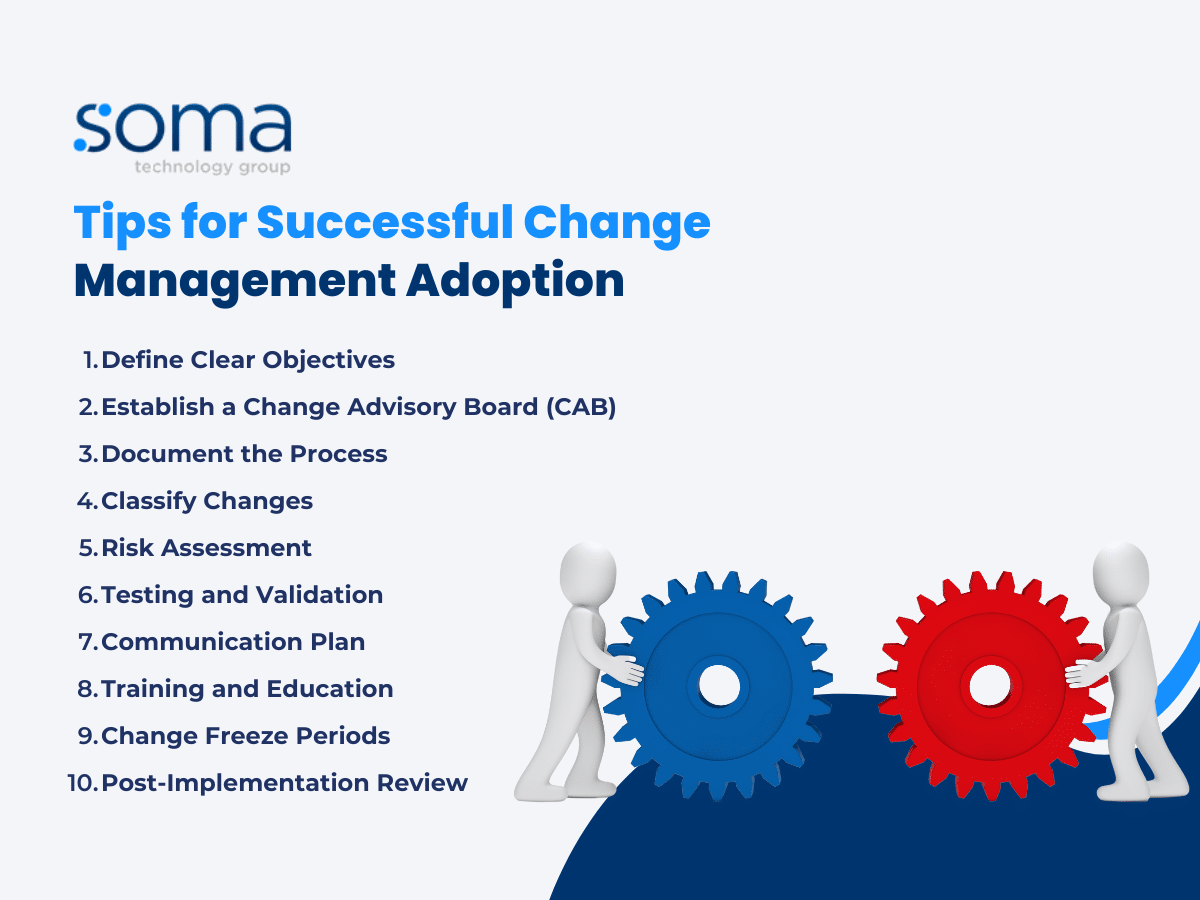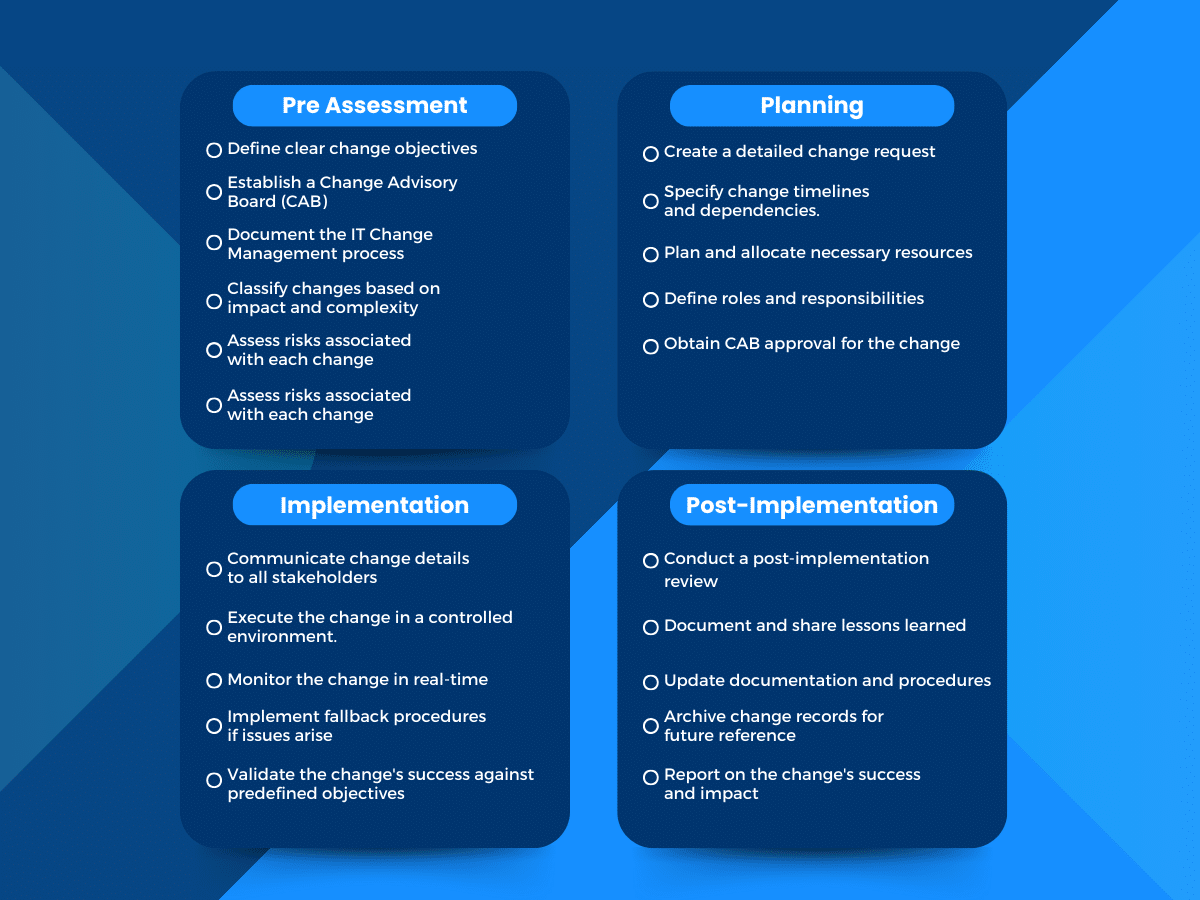In today’s technology-dependent world, change is inevitable in business. Organisations must constantly adapt to technological advancement to stay competitive and thrive. However, managing tech changes can be challenging. Change initiatives can face resistance, setbacks, and even failure if mishandled.
This is where IT change management comes into play. This article offers valuable insights, strategies, and a practical checklist to facilitate the seamless adoption of IT changes, ensuring that they align with organisational goals, enhance system reliability, and mitigate potential disruptions.
What is IT Change Management?
IT Change Management is a crucial process that ensures smooth transitions and successful implementation of changes within an organisation’s IT infrastructure. Basically, it refers to the structured approach used to manage any modifications made to hardware, software, networks, systems, or applications.
It involves various strategies such as planning, coordinating, and controlling all changes to minimise disruption and maximise the benefits of new technologies or processes. Likewise, it encompasses multiple activities such as assessing the impact of changes, creating change requests, obtaining approvals, communicating with stakeholders, implementing changes, and evaluating their effectiveness.
The Importance of Change Management

As mentioned, IT change management is vital in ensuring smooth transitions during IT implementations or modifications. It enhances stability, minimise risks, promotes team collaboration, ensures business continuity, and enables organisations to adapt quickly to changing environments.
Similarly, here are some key reasons why IT Change Management is vital:
1. Risk Mitigation
Unplanned or poor changes in your IT system can lead to system failures, data breaches, and operational disruptions. IT Change Management helps identify potential risks and devise strategies to mitigate them, reducing the likelihood of adverse outcomes.
One of the critical ways IT Change Management mitigates risk is through thorough assessment and analysis of proposed changes. This involves evaluating the potential impact of the change on various aspects such as system availability, performance, security, and compliance. With this, organisations can identify potential risks and develop strategies to minimise or eliminate them.
2. Compliance and Governance
Compliance and governance are essential for organisations operating in industries subject to regulatory oversight. Compliance with these regulations is necessary to avoid legal repercussions and maintain the trust of stakeholders. Failure to comply with these regulations can result in severe penalties and reputational damage.
IT Change Management helps organisations stay compliant by providing a systematic framework for assessing the impact of proposed changes on regulatory requirements. This framework includes actors like security, data privacy, and regulatory compliance. Through this, organisations can make informed decisions about whether to proceed with a change, delay it, or implement additional security measures to mitigate risks.
3. Operational Stability
Operational stability is vital for organisations. It directly impacts productivity, customer satisfaction, and overall business performance. Any downtime or instability in operations can disrupt business processes, resulting in lost revenue, damage the organisation’s reputation, and even lead to legal or regulatory issues in some cases.
Through effective IT Change Management practices, businesses can proactively identify potential risks before implementing changes. This allows them to assess the impact on existing systems and develop strategies for risk mitigation.
Likewise, effective change management ensures that systems and services remain stable during and after the implementation of changes. This stability is crucial for business continuity and customer satisfaction.
4. Cost Control
The cost of IT changes, often called the “cost of change” in IT management, encompasses various expenses associated with planning, implementing, and maintaining changes to an organisation’s information technology infrastructure, systems, and applications. And mismanaged changes can be costly, leading to increased downtime, service outages, and emergency fixes.
Proper IT Change Management helps control costs by reducing the frequency and impact of unexpected incidents.
5. Increasing Efficiency
IT change management is instrumental in increasing efficiency within an organisation. Change initiatives often aim to improve processes and workflows. It establishes standardised processes and workflows for requesting, reviewing, testing, and implementing changes. Effective change management ensures that these improvements are implemented successfully.
Moreover, change management helps prioritise IT changes based on their business impact and urgency. Organisations can allocate their time and efforts more efficiently by focusing resources on high-priority changes, addressing critical needs first.
10 Tips for Successful Change Management Adoption

Now that we understand the importance of IT change management, let’s delve into the practical aspects of adopting it successfully. Adopting IT Change Management requires a well-defined strategy and a commitment to follow best practices.
Here are some tips to help your organisation successfully implement IT Change Management:
1. Define Clear Objectives
Having clear and well-defined objectives in IT change management is of paramount importance. Without clear goals, IT changes may lack direction and lead to misalignment with the overarching business strategy.
As such, begin your IT changes by setting clear and specific goals for your IT Change Management process. Identify what you want to achieve, such as reducing downtime, improving system performance, or enhancing security.
2. Establish a Change Advisory Board (CAB)
The Change Advisory Board (CAB) is a crucial component of IT change management within an organisation. It is a group responsible for reviewing, evaluating, and approving proposed IT changes, ensuring that they align with business objectives, are executed efficiently, and minimise risks to IT services and operations.
Likewise, form a CAB comprising key stakeholders, including IT leaders, business representatives, and compliance experts. The CAB will then evaluate and approve changes based on their potential impact.
3. Document the Process
Documenting the process in IT change management is critically important. Documentation establishes a standard and consistent approach to managing IT changes. This consistency helps ensure that changes are handled uniformly, reducing the risk of errors, oversights, or deviations from best practices.
Create a comprehensive IT Change Management policy and document the entire change process. Include procedures for requesting, reviewing, testing, and implementing changes. Ensure that all stakeholders are aware of and have access to these documents.
4. Classify Changes
Classifying changes allows you to assess the potential risks associated with each type of change. Different types of changes may have varying levels of risk. You can allocate resources and mitigation strategies based on the perceived risk level.
To start, you can categorise changes based on their impact and complexity. This classification helps determine the scrutiny and testing required for each change. Typical categories include standard changes, minor changes, and significant changes.
5. Risk Assessment
Not all IT changes carry the same level of risk. Risk assessment helps identify potential risks and vulnerabilities associated with proposed IT changes. In addition, it enables organisations to prioritise changes based on their potential impact and likelihood of occurrence.
Thus, always perform a risk assessment for each change. Identify potential risks, their likelihood, and potential impact. Develop risk mitigation strategies and contingency plans to address any unforeseen issues.
6. Testing and Validation
Testing and validation processes help identify errors, defects, or issues in the proposed IT changes before they are deployed into the production environment. This proactive approach prevents potentially disruptive and costly problems from impacting live systems.
Likewise, remember to test changes in a controlled environment thoroughly before deployment. Validate that the changes meet the predefined objectives and do not negatively affect existing systems or services.
7. Communication Plan
IT changes often impact a wide range of stakeholders, including employees, customers, vendors, and management. A communication plan ensures that all relevant parties are aware of the upcoming changes, their purpose, and their potential impact.
As such, implement a communication plan to keep all stakeholders informed throughout the change process. Clearly communicate the change’s purpose, timeline, and potential impact to minimise confusion and overcome resistance.
8. Training and Education
Once you complete the abovementioned steps, it’s time to educate your whole company and team. Training gives stakeholders the necessary knowledge and skills to use and manage these changes effectively. It also ensures that employees and team members are competent in using the new systems or processes introduced by the change.
As such, always ensure that your team is well-trained in change management procedures and tools. To train and educate in IT change management, create a tailored training plan with clear objectives and materials, using a mix of interactive methods to engage participants. Continuously gather feedback, offer post-training support, and foster a culture of learning to ensure successful adoption of IT changes.
9. Change Freeze Periods
The tolerance for system disruptions or failures is low during critical periods, such as year-end financial reporting or peak sales seasons. Likewise, implementing a change freeze is essential as it reduces the risk of introducing changes that could disrupt operations, cause outages, or lead to critical failures.
10. Post-Implementation Review
After implementing changes, conduct a post-implementation review. A Post-Implementation Review (PIR) in IT change management is a structured assessment and evaluation process conducted after implementing a significant IT change. Its primary purpose is to assess the success and effectiveness of the change, identify lessons learned, and gather feedback to inform future change management efforts.
Thus, after changes, always identify lessons learned and areas for improvement to refine your change management processes continually.
IT Change Management Checklist
To facilitate the adoption of IT Change Management, here is a comprehensive checklist that you can use as a reference:

Conclusion
In conclusion, effective IT change management is the linchpin to ensuring the success and resilience of your organisation in today’s rapidly evolving tech landscape. It requires careful planning, clear communication, and a structured approach.
We hope this article provided valuable resources and steps to enhance your IT change management process. If you’re looking to streamline your IT change management processes, consider soma Technology Group as your trusted partner.
With our proven expertise and a track record of successful IT change management implementations, soma Technology Group can help you navigate the complexities of change. Contact us now!



